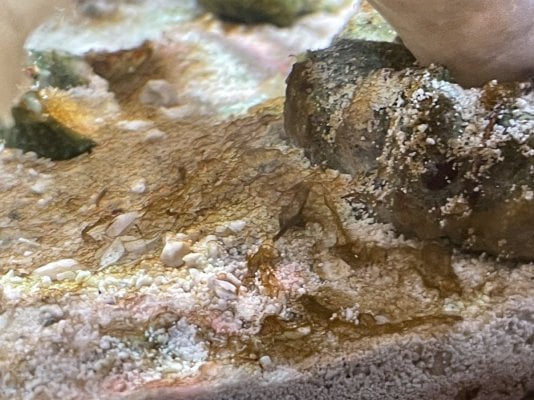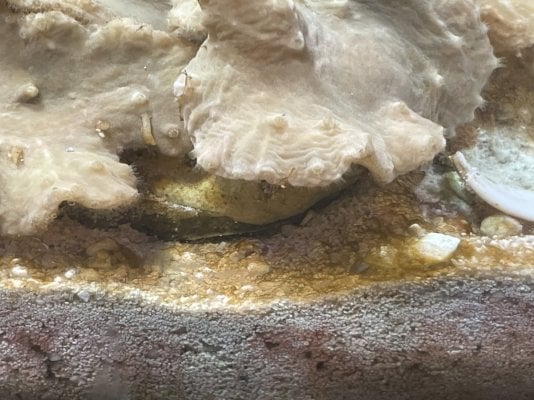Yes. I agree. I feel like this is a bit confusing for new reefers reading numbers on test kits. Gotta think about it a little beyond the numbers... What's actually growing etcThere are always nutrients in a tank (if not, everything would be dead). Dinos can outcompete other algaes because they can utilize nutrients at very low levels.
The theory on raising nutrients is to get a different algae (GHA) to outcompete the dinos.
Navigation
Install the app
How to install the app on iOS
Follow along with the video below to see how to install our site as a web app on your home screen.
Note: This feature may not be available in some browsers.
More options
You are using an out of date browser. It may not display this or other websites correctly.
You should upgrade or use an alternative browser.
You should upgrade or use an alternative browser.
Possible to have Dinos with high nutrients?
- Thread starter swoons
- Start date
- Tagged users None
- Joined
- Sep 21, 2018
- Messages
- 7,571
- Reaction score
- 7,962
I have definitely seen green algae take over diatom cultures. I don’t know why this happens but it is reproducible. I have not so far been able to show the same thing with dinoflagellates, but I am no where close to running out of ideas for trying to observe a nutrient effect with dinoflagellates. So far increasing nutrients produces real dino horror show.There are always nutrients in a tank (if not, everything would be dead). Dinos can outcompete other algaes because they can utilize nutrients at very low levels.
The theory on raising nutrients is to get a different algae (GHA) to outcompete the dinos.
I tried with less and never worked. If I start at 1ppm/day usually it takes a week to see dino slowing down. At that point I start to dose more by 10% increments every day and in 7 days more they are gone. However I never reached the point where I get a huge diatom outbreak. From my understanding after reading randy's guide on silicate dosing, it seems that there are no huge negative effects of overdosing silicate.generally agree with the sentiment, but 1ppm Si/day sounds really aggressive. I'd be more likely to advise 1/10 of that, certainly if you don't have a reliable Si kit (I've only had clearly positive reports from hanna or hach) .
I do not have a test kit. When dinos are gone I cut by 50% the dosing and then slowly decrease until I dose 0.1 ppm/day. Then I keep dosing that to maintain my sponge population. Only issue is that I cannot trust my PO4 measures in this way. Do anyone know if the "normal" colorimetric PO4 tests (e.g. salifert) work with high silicates ?
- Joined
- May 22, 2016
- Messages
- 6,970
- Reaction score
- 10,747
Excellent. Good observations.I tried with less and never worked. If I start at 1ppm/day usually it takes a week to see dino slowing down. At that point I start to dose more by 10% increments every day and in 7 days more they are gone. However I never reached the point where I get a huge diatom outbreak. From my understanding after reading randy's guide on silicate dosing, it seems that there are no huge negative effects of overdosing silicate.
I do not have a test kit. When dinos are gone I cut by 50% the dosing and then slowly decrease until I dose 0.1 ppm/day. Then I keep dosing that to maintain my sponge population.
When I measured Si starting dosing, I found that obvious diatom growth started for me at a couple of tenths ppm SiO2, and I did not grow diatoms more or faster when ramping up to 1-2ppm SiO2. It suggested that maybe the diatoms could get the Si they needed at the level of a few tenths, and more didn't dramatically change things.
Both sets of observations are helpful. I imagine systems can respond quite differently in these cases. Ymmv.
Yes it could easily be that simply it takes time for the dinos to disappear and my scaling up the dose is not necessary. Patience is something we are not used to anymore... The important thing is that in my system I found an almost bulletproof solution for LCA and Ostreo outbreaks. I can always see some small LCA patches in the tank but as soon as they don't spread they are daily eaten/buried by the conch. For me it's great news, so much more peace of mind! Thanks for all the suggestions!Excellent. Good observations.
When I measured Si starting dosing, I found that obvious diatom growth started for me at a couple of tenths ppm SiO2, and I did not grow diatoms more or faster when ramping up to 1-2ppm SiO2. It suggested that maybe the diatoms could get the Si they needed at the level of a few tenths, and more didn't dramatically change things.
Both sets of observations are helpful. I imagine systems can respond quite differently in these cases. Ymmv.
Hi I have brown rusty looking algae and yes my nutrients dropped also. I messed around with magnesium and calcium and found out…..Coral Euphoria on YouTube had a video where he was adamant that it’s not low nutrients where Dinos are likely to appear, but that it’s a tank imbalance that kicks it off and messes up the biome, the nutrients give them a foothold, and then by the time you notice Dinos, they’ve already consumed all the nutrients down to zero, so people have simply associated low nutrients with Dinos. He claims that’s backwards, and that you’re seeing low nutrient tests BECAUSE of the Dinos, not that low nutrients cause Dinos. I’m not sure about that and found it interesting … but anyways, in your case, brown/rusty algae-looking stuff could be chrysophytes … cyano … a few other things. Could you post photos?
I have photos. Your post says that cyanide can be brown, any help identifying this gross algae dino cyano whatever?
Attachments
That indeed looks like dino to me but the only safe confirmation comes with a microscope. It doesn't need to be powerful/expensive. This said my experience is that if you have brown/reddish rust on sand/rocks and it goes away at night and comes back with light, is for sure Dino. If it does not show this behaviour though, it is not safe to assume that is NOT a dinoflagellate outbreak. Then you need to identify which one because different species need different treatments. They all can be reduced to the point where you don't see them anymore, with a lot of patience. How old is the tank?Hi I have brown rusty looking algae and yes my nutrients dropped also. I messed around with magnesium and calcium and found out…..
I have photos. Your post says that cyanide can be brown, any help identifying this gross algae dino cyano whatever?
Yes it nearly is gone at night. I just had this under control I messed around with magnesium and calcium and added Live Photo and reef plus and this came back after it was gone.That indeed looks like dino to me but the only safe confirmation comes with a microscope. It doesn't need to be powerful/expensive. This said my experience is that if you have brown/reddish rust on sand/rocks and it goes away at night and comes back with light, is for sure Dino. If it does not show this behaviour though, it is not safe to assume that is NOT a dinoflagellate outbreak. Then you need to identify which one because different species need different treatments. They all can be reduced to the point where you don't see them anymore, with a lot of patience. How old is the tank?
I’m so mad. And doing siphoning makes it worse in my experience. Makes it better short term and then comes back full force.
How can this happen in an established tank? I thought people always say it only happens in new tanks! So frustrating I’m about ready to shut it down because I’m tired of this coming back. I’ve spent a fortune treating it.
Last thing I’m doing is Dino x if that doesn’t work or kills corals I’m out.
Did you read this thread from the beginning? No need to panic, it will be gone with proper treatment. Silica dosing+ feeding+ dark treatment worked every single time for me since this thread was written. I had the biggest outbreak of Dino one year after tank was established. If it's Ostreopsis you need a good UV filter
Also, imho stop adding stuff to your tank and fiddling with parameters. Just find out dosing regime and keep it stable, also no need to check too much nutrients level. I had tank with PO4 as high as 1ppm and nothing died, I just reduced feeding pellet and increased fuge light gradually.
Tried it all before was temporary all came back and spent a fortune on bacteria’s, pods etc. tried h2O2 only made it worse in the past. I have large cell anphidinuim in was told before.Did you read this thread from the beginning? No need to panic, it will be gone with proper treatment. Silica dosing+ feeding+ dark treatment worked every single time for me since this thread was written. I had the biggest outbreak of Dino one year after tank was established. If it's Ostreopsis you need a good UV filter
It’s a 25p so 25 gallon and any changes from doing small water changes seem to be able to trigger it also.
It will be gone soon, but it is also always there ready to take hold.
that’s the bloody issue.
I have 2 powerful UV green machine filters in the tank and it does nothing for the Dino.
I’m already ordered the Dino x another 120$ spent trying to fix this bloody mess.
I’m at my end, and the Dino x will hopefully get rid of it once and for all
Similar threads
- Replies
- 1
- Views
- 180
- Replies
- 1
- Views
- 90
- Replies
- 1
- Views
- 139
- Replies
- 4
- Views
- 142



















